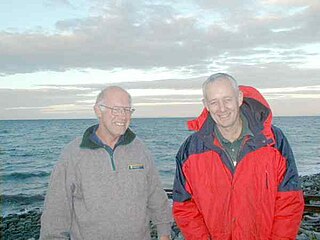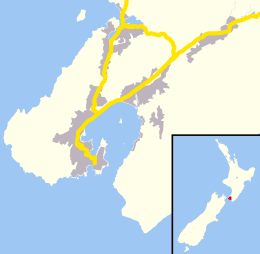
Porirua, a city in the Wellington Region of the North Island of New Zealand, is one of the four cities that constitute the Wellington metropolitan area. The name 'Porirua' is a corruption of 'Pari-rua', meaning "the tide sweeping up both reaches". It almost completely surrounds Porirua Harbour at the southern end of the Kāpiti Coast. As of 2023, Porirua has a population of 62,400 people, and is a diverse city with 26.5% of the population identifying as Pasifika and 23.0% of the population identifying as Māori.

The kākāpō, sometimes known as the owl parrot or owl-faced parrot, is a species of large, nocturnal, ground-dwelling parrot of the superfamily Strigopoidea. It is endemic to New Zealand.

The animals of New Zealand, part of its biota, have an unusual history because, before the arrival of humans, less than 900 years ago, the country was mostly free of mammals, except those that could swim there or fly there (bats). However, as recently as the Miocene, it was home to the terrestrial Saint Bathans mammal, implying that mammals had been present since the island had broken away from other landmasses. The absence of mammals meant that all of the ecological niches occupied by mammals elsewhere were occupied instead by either insects or birds, leading to an unusually large number of flightless birds, including the kiwi, the weka, the moa, the takahē, and the kākāpō.

The suburb of Plimmerton lies in the northwest part of the city of Porirua in New Zealand, adjacent to some of the city's more congenial beaches. State Highway 59 and the North Island Main Trunk railway line pass just east of the main shopping and residential area.

Tiritiri Matangi Island is located in the Hauraki Gulf of New Zealand, 3.4 km (2.1 mi) east of the Whangaparāoa Peninsula in the North Island and 30 km (19 mi) north east of Auckland. The 2.2 km2 (1 sq mi) island is an open nature reserve managed by the Supporters of Tiritiri Matangi Incorporated, under the supervision of the Department of Conservation and is noted for its bird life, including takahē, North Island kōkako and kiwi. It attracts between 30,000 and 32,000 visitors a year, the latter figure being the maximum allowed by the Auckland Conservation Management Strategy.

Farewell Spit is a narrow sand spit at the northern end of the Golden Bay, in the South Island of New Zealand. The spit includes around 25 km (16 mi) of stable land and another 5 km (3.1 mi) of mobile sand spit running eastwards from Cape Farewell, the northern-most point of the South Island. Farewell Spit is the longest sand spit in New Zealand, and is a legally protected Nature Reserve. The area is designated as a Ramsar wetland site and an East Asian–Australasian Flyway Shorebird Network site. Farewell Spit is administered by the Department of Conservation as a seabird and wildlife reserve. Apart from a small area at the base of the spit, it is closed to the public except through organised tours. Conservation initiatives are in progress towards eliminating mammalian predators from Farewell Spit, including a proposal for a predator-proof fence.

The New Zealand kākā is a large species of parrot of the family Strigopidae found in New Zealand's native forests across the three main Islands of New Zealand. The species is often known by the abbreviated name kākā, although it shares this name with the recently extinct Norfolk kākā and Chatham kākā. Two subspecies of New Zealand kākā are recognised. It is endangered and has disappeared from much of its former range, though the re-introduction of North Island kākā at Zealandia in Wellington has led to an increasing population of the birds across the city.

Stephens Island is at the northernmost tip of the Marlborough Sounds in the South Island of New Zealand. It lies two kilometres to the northeast of Cape Stephens, the northernmost point of D'Urville Island. The island is 1.5 square kilometres in size, and rises 283 metres (928 ft) high from the sea.

Donald Vincent Merton was a New Zealand conservationist best known for saving the black robin from extinction. He also discovered the lek breeding system of the kākāpō.

The Chatham Islands petrel, also known as the Chatham petrel or ranguru (Māori), is a medium-sized, grey, white and black gadfly petrel. It only breeds on the Chatham Islands, New Zealand, and until recently was restricted to the 218-hectare Rangatira or South-East Island.
An ecological island is a term used in New Zealand, and increasingly in Australia, to refer to an area of land isolated by natural or artificial means from the surrounding land, where a natural micro-habitat exists amidst a larger differing ecosystem. In New Zealand the term is used to refer to one of several types of nationally protected areas.

Anchor Island is an island in Dusky Sound in Fiordland.

Deinacrida rugosa, commonly called the Cook Strait giant wētā or Stephens Island wētā, is a species of insect in the family Anostostomatidae. The scientific name Deinacrida means "terrible grasshopper" and rugosa means "wrinkled". It is endemic to New Zealand.

The Māori people have had a strong and changing conservation ethic since their discovery and settlement of New Zealand. This is closely tied to their spiritual beliefs.

Belmont Regional Park is a regional park located between Lower Hutt and Porirua, in the Wellington Region at the southern end of New Zealand's North Island. It is administered by Wellington Regional Council. It was the first park in New Zealand to include land for recreation, conservation, and farming.

Anthony Hume Whitaker was a New Zealand herpetologist, contributing a 50-year career of fieldwork, pioneering research and species discoveries. His is still the largest collection of reptile and amphibian specimens donated to Museum of New Zealand Te Papa Tongarewa.

Lyperobius huttoni is a New Zealand weevil found in alpine areas of the South Island and at sea level around the Wellington coast. It feeds only on speargrass (Aciphylla). Weevils from the endangered Wellington population have been translocated to predator-free Mana Island.

James Robert Lynch is a New Zealand cartoonist and conservationist. Lynch is best known as the founder of eco-sanctuary Zealandia in Wellington.

The New Zealand Department of Conservation has introduced a number of animal and plant species to Mana Island, near Porirua, New Zealand, as part of an ecological restoration programme since taking over conservation management of the island in 1987. Some were reintroductions of species wiped out during years of agricultural use or the subsequent explosion in the number of house mice on the island. A pest control programme eliminated the mice by 1990 and many species have been introduced since. Notable successes include the spotted skink, Duvaucel's gecko and the flax weevil, which are now regarded as well established, and the yellow-crowned parakeet, which has been described as abundant and widespread. Attempts have been made to introduce several seabird species in what the Department of Conservation describes as "the world's most complex seabird translocation project"; results have been mixed.

Whitireia Park is a headland north of Tītahi Bay and Te Awarua-o-Porirua Harbour in Porirua, in the Wellington Region at the southern end of New Zealand's North Island. It is a park administered by the Whitireia Park Board, in collaboration with Wellington Regional Council. The park includes Onehunga Bay, Kaitawa Point and part of Rocky Bay.























